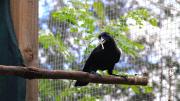Long gone are the days when animal behaviorists, in the tradition of Harvard psychologist B.F. Skinner, assumed animals were robotic stimulus-response machines. A wealth of recent evidence supports the idea that animals think and feel; corvids—a family of birds including crows, ravens, magpies, and others—have been one frequent subject of such research. They’ve been shown to use complex tools, recognize human faces, and even throw hard-shelled nuts onto roads so passing cars will run over and crack them. A new study published this month in Current Biology, led by organismic and evolutionary biology graduate student Dakota McCoy, argues that crows also gain intrinsic pleasure from making and using tools, and that this puts them in a better, more optimistic mood. “Perhaps crows use tools for partially the same reason we play chess and paint pictures,” a video abstract for the study says. “It’s fun.”
McCoy and her team, a group of researchers at the University of Auckland in New Zealand, studied New Caledonian crows, a famously smart species found in that French territory in the Pacific. The crows have independently developed multiple types of tools that require “substantial manufacturing,” McCoy explains: stick tools made by trimming leaves off branches, hook tools made by trimming branches close to a junction, and “leaf-based-tools, where they cut a shape out of a pandanus plant leaf with spines along one edge that can also act as hooks.” The birds use all this technology to obtain food, “often by probing beneath bark or into crevices.”
Corvids, McCoy explains, represent “one of the other evolutions of complex intelligence in the animal kingdom,” along with well-known cases like primates and dolphins. “We [used to think] with their small cortexes that they could not be capable of higher cognition, but we now know that they clearly are.” Bird brains may be much smaller than those of mammals, but they’re incredibly dense. “They’ve got a ton of neurons that are just packaged differently from primate brains. So it’s really neat: we get a chance to see how intelligence works when it evolved on a completely different evolutionary trajectory.”
A crow makes a stick tool, a natural behavior for this species, during free time from the experiment.
Video courtesy of Dakota McCoy
For her study, McCoy wanted to test how the birds’ emotions might interact with tool use. She was familiar with an established methodology used to understand animals’ moods. “Animal emotions have been a source of controversy for years,” she says. “We’ve got a rigorous tool to peer into their minds, and that’s by using ambiguous stimuli.” Much the way people interpret a glass as half full or half empty depending on their mood, McCoy explains, “you can construct the same sort of paradigm with animals and get a sense of what their generalized mood is…If you want to test how tool use makes a crow feel, you have to test whether they’re more or less optimistic [afterward], which in turn suggests tool use improves their mood.”
She and her colleagues captured 15 New Caledonian crows for the study, housed them in an aviary, and trained them to understand that a box placed on the left side of a table contained three large blocks of meat (“high-quality steak,” McCoy says), and a box on the right side contained only a small scrap. The big reward was much more enticing: the birds flew to it in about four seconds, versus about 25 seconds for the small one. “We know that the speed with which an animal approaches something tells you something about their expectations,” McCoy says.
Then, to test how using tools would affect the crows’ future behavior, each bird was primed with a meat reward between two sheets of acrylic glass: some could simply grab it with their beaks, and for others it was out of reach, so they had to use a stick tool. After that, the birds were presented with a mystery box—the “ambiguous” stimulus akin to a glass-half-full/half-empty scenario. The box was placed in the middle of the table, so that they didn’t know how much food to expect inside. Birds who had just obtained meat using a tool flew to the mystery box more quickly—after about 12.14 seconds; those who’d needed only their beaks took 22.5 seconds.
The team also had to determine whether it was the time and effort needed to get the meat using a tool, rather than the tool itself, that created the apparent difference in the birds’ optimism. In addition to the tool versus no tool condition, the birds were also given a task where they could either pick up meat cut into four pieces on the table—easily within reach—or fly around the aviary to pick up the meat pieces. If time or effort alone affected the crows’ mood in the same way tool use did, the researchers would expect similar outcomes from the tool task and the flying-around-the-aviary task. But the opposite happened: crows that were primed with an easy-effort task were quicker to fly to the mystery box than those who had to fly around the aviary. Something special about having used the tool itself had made the birds optimistic.
“The most challenging aspect of this kind of study is, you can’t just ask a crow, ‘How are you feeling?’” McCoy says. Animals’ inner experiences can be accessed only indirectly. “I feel pretty confident that we managed to isolate the effect of tool use,” she says, but, she adds, this sort of research “definitely has to be replicated.”
It’s easy to imagine evolutionary explanations for the study’s finding. “Emotions exist to reinforce things that are evolutionarily adaptive,” McCoy explains. Just as humans get pleasure from cognitively challenging tasks and games, “crows seem to intrinsically enjoy tool use.” The findings also have animal-welfare implications, McCoy adds, and reflect the importance of providing animals in captivity with “complex, species-specific enrichment…that replicates the positive conditions they would experience in an otherwise unaltered life.
“It’s taken years of overturning Skinner theory to be able to say this, but it’s no surprise that animals experience positive feelings when they do adaptive things,” she continues. “It seems that those positive moods can spill over into just using a tool and playing around with a tool for fun. Emotions are intertwined with the development of complex, species-specific action, much more broadly across the animal kingdom than we might have thought previously.”









